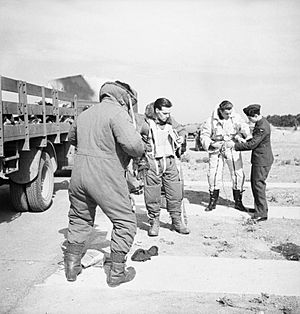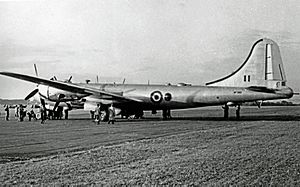No. 90 Squadron RAF facts for kids
Quick facts for kids No. 90 Squadron RAF |
|
|---|---|
| Active | 8 October 1917 - 29 July 1918 14 August 1918 - 13 June 1919 15 March 1937 - 6 April 1940 3 May 1941 - 10 February 1942 7 November 1942 - 1 September 1950 4 October 1950 - 1 May 1956 1 January 1957 – 1 March 1965 |
| Country | |
| Branch | |
| Motto(s) | Latin: Celer ("Swift") |
| Insignia | |
| Squadron badge heraldry | A hind salient. The Hind - "representative of vigilance and great speed" - commemorates the fact that, at one time, the squadron was equipped with Hind aircraft. |
| Squadron Codes | TW Oct 1938 - Sep 1939 WP May 1941 - Sep 1950, Oct 1950 - Apr 1951 XY Mar 1943 - Oct 1944 carried by 'C' Flt only |
No. 90 Squadron RAF (sometimes called No. XC Squadron) was a special group of planes and pilots in the Royal Air Force. They flew many different types of aircraft over the years, from World War I to the Cold War.
History of No. 90 Squadron
World War I Missions
No. 90 Squadron first started on 8 October 1917. It was a fighter squadron for the Royal Flying Corps. They were based at RAF Shawbury in Shropshire.
The squadron moved to RAF Sealand in North Wales in December 1917. They used several types of planes, like the Avro 504 and Sopwith Pup. The squadron was supposed to get new Sopwith Dolphin fighters. They hoped to fly missions in France by spring 1918. However, the squadron was disbanded on 3 August 1918 before it could start fighting.
The squadron was formed again on 14 August 1918. This time, it was a Home Defence squadron. They used Avro 504K planes. Their job was to protect the Midlands from German air attacks. The squadron had planes based at Buckminster, Leadenham, and Wittering. But they never saw any action. The squadron was disbanded again on 13 June 1919.
World War II Operations
No. 90 Squadron reformed at RAF Bicester on 15 March 1937. It started as a light bomber squadron. Their first planes were Hawker Hind biplanes. Soon after, they got more modern Bristol Blenheim planes. These were twin-engined monoplanes.
In early 1939, they upgraded to Blenheim Mark IVs. When Second World War started, the squadron became a training unit. They trained Blenheim crews for other bomber squadrons. On 4 April 1940, the squadron disbanded. It joined with No. 35 Squadron.

The squadron reformed again on 7 May 1941 at RAF Watton. It was the only squadron in Bomber Command with the American Boeing Fortress I. This was a large, four-engined bomber. Their first mission was on 8 July 1941. Three Fortresses flew from RAF Polebrook to attack Wilhelmshaven in Germany.
The squadron usually flew small groups of Fortresses. They attacked targets from very high up during the day. On 24 July, they attacked the German battleship German battleship Gneisenau in France. The Fortresses attacked from 30,000 feet. This was meant to draw away German fighters. Other planes, like Handley Page Hampdens and Vickers Wellingtons, would then attack. The plan did not work as expected. The Fortresses faced no resistance. German fighters focused on the other planes.
Small attacks continued. On 8 September, four Fortresses attacked the German "pocket battleship" Admiral Scheer in Oslo. They lost two planes to German fighters. No. 90 Squadron flew its last mission over northern Europe on 25 September 1941. The Fortress I planes were not ideal for the very high-altitude missions the RAF used them for. The squadron disbanded on 14 February 1942.
On 7 November 1942, the squadron reformed again. This time, it was a night bomber squadron. They were part of No. 3 (Bomber) Group. They were based at RAF Bottesford. They received their first Short Stirling Mk.I plane on 1 December. Their first missions were laying mines on 8 January 1943.
The squadron later got the improved Stirling Mk.III. They moved to RAF Wratting Common on 31 May 1943. The squadron had three flights, meaning they could send 24 planes on missions. They took part in the Battle of the Ruhr. They attacked many heavily defended German cities, including Berlin. The squadron suffered many losses during this time.
The Stirling planes had some design problems. Because of this, they were later used for special missions. These included dropping sea mines and supplying the French Resistance (Maquis). They also flew shorter bombing raids.
By June 1944, the squadron started using Lancaster bombers. Their last bombing raid was to Bremen on 22 April 1945. During the war, the squadron flew 4,613 missions. They lost 86 aircraft.
Two books have been written about airmen from 90 Squadron. One is an autobiography by Robert E. Wannop DFC, called 'Chocks Away.' The other is about Wannop's tail gunner, James Cyril McCaffery. It is called 'Dad's War: The Story of a Courageous Canadian Youth who flew with Bomber Command.' It was written by McCaffery's son, Dan McCaffery. Robert E. Wannop and James McCaffery flew 22 missions together. They were with the squadron until the war ended.
Postwar Era
After the war, the squadron continued to use Lancaster planes. In May 1947, they switched to Lincolns. They often went on detachments to Egypt and Rhodesia. The squadron disbanded on 1 September 1950.
The squadron reformed again at RAF Marham on 4 October 1950. They were equipped with the B-29 Superfortress. In Great Britain, this plane was known as the Boeing Washington.
On 8 January 1953, a Washington plane from the squadron, WF502, crashed. It flew into the ground at night near Llanarmon-yn-Ial in Denbighshire. All 10 crew members sadly died.
In November 1953, the squadron started using Canberra planes. The squadron was disbanded on 1 May 1956.
On 1 January 1957, the squadron reformed at RAF Honington. It became a V-Bomber squadron. They received Vickers Valiant planes in March of that year. In August 1961, the squadron began to focus on in-flight refueling. They became a dedicated tanker unit on 1 April 1962. This meant their main job was to refuel other planes in the air.
However, the Valiant planes developed structural problems. These were caused by metal fatigue. Because of this, the RAF's Valiant fleet was permanently grounded on 26 January 1965. The squadron finally disbanded on 16 April 1965.



